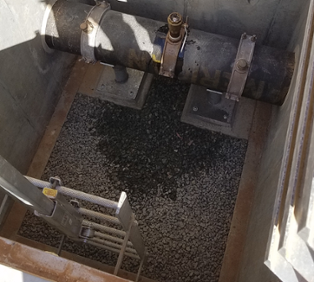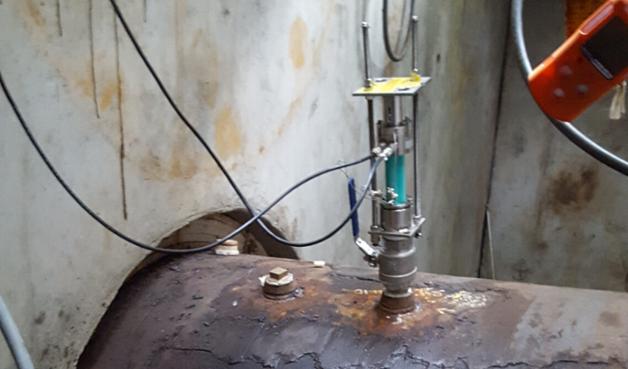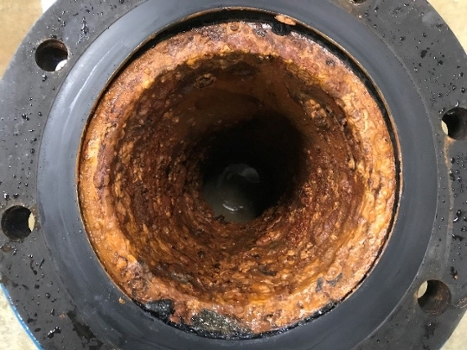The Guide to Investing in Effective Tools for I&I Data Management in Sanitary Sewer Systems
Overseeing a sanitary sewer system is a monumental task for any wastewater engineer, made even more challenging by managing inflow and infiltration (I&I) problems during the wet season. High amounts of stormwater runoff and an aging pipeline infrastructure can lead to a wastewater system overload and potentially cause significant environmental and safety issues for the community at large.
Managing I&I is a priority for all wastewater treatment plants (WWTPs), who spend weeks of time surveying and analyzing data from a large network of pipelines and prioritizing repairs, which can also be an overwhelming challenge.
Despite limited funding, wastewater engineers and utility managers who invest in effective tools for I&I data management can save time and much-needed budget to reduce the impact of I&I on their wastewater systems.
In this guide, we’ll dive into what you need to know about managing inflow and infiltration (I&I), how successful wastewater engineers monitor overflowing sewer systems in real-time and understand the necessary resources for a study on stormwater data.
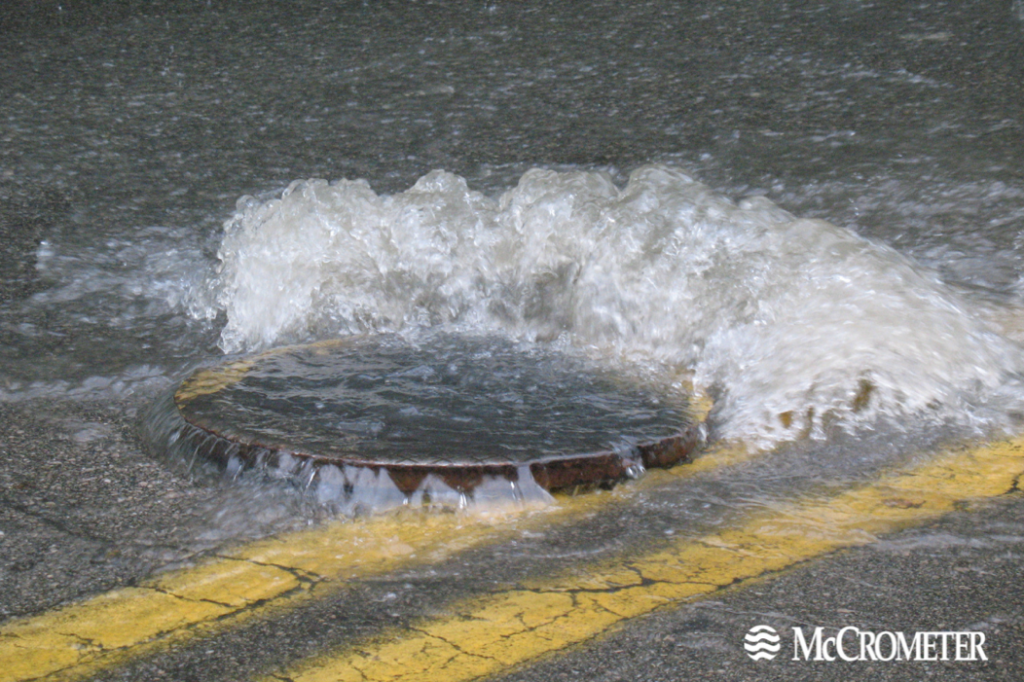
An image of a flooded manhole, considered a source of inflow.
What is Influent and Infiltration (I&I)?
Coined by municipal water engineers, I&I is the terminology used for groundwater that starts from heavy rainfall infiltrating a sanitary sewer system through direct or indirect points of entry. I&I adds large volumes of untreated water into a sanitary sewer system that will enter wastewater collection pipelines, adding to treatment costs and possibly overflowing the system.
Inflow is clean water, such as storm runoff or groundwater, entering the sanitary sewer system through direct points such as manholes, sump pumps, and foundation drains.
Infiltration is water entering the sanitary sewer system through indirect spots such as cracks or leaks in the existing pipelines.
Methods for Monitoring Overflowing Sanitary Sewers
The Environmental Protection Agency (EPA) estimates the cost of collecting and treating wastewater to range from $2 – $5 per thousand gallons, meaning that an annual I&I volume of 150 million gallons could increase costs by anywhere from $300,000 to $750,000 to treat
Stormwater data analysts have a bevy of surveillance methods at their disposal to collect stormwater data, including smoke and dye testing, CCTV, hydraulic modeling, manhole inspections, groundwater monitoring, and more. However, precise data measurement is often required to estimate how much water volume is infiltrating a sanitary sewer system. Paramount to these methods is flow monitoring, which is a smart first step when identifying and reporting inflow and infiltration.
Flow Monitoring
Flow monitoring for sanitary sewer systems is a popular method to survey and analyze I&I in wet weather events, especially in the past 20 years when the technology of flow meters improved, and the development of smart flow meters has permeated the industry. In the 1960s and 1970s when mechanical meters were the main devices available, manual meter reading was still necessary, requiring significant manhours and labor-intensive data collection.
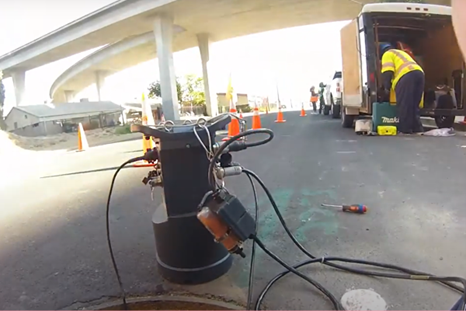
A manhole installation of the FLO-DAR, a flow metering solution for I&I. Permission from Oratech Controls.
In recent years, wastewater engineers benefit from digital and wireless communication outputs from flow meters, integration with SCADA (Supervisory Control and Data Acquisition) systems, and other IoT automation to perform short and long-term monitoring. This constant data collection allows users to establish a control point and then compare data from inclement weather events and determine outliers for further investigation.
While data is continuous, it offers limited insight into the source of the I&I. Engineers monitoring flow data through computer software are only able to quantify the amount of I&I entering the system, not determine the cause. Additionally, the initial cost of flow monitoring can be pricy for municipalities on a budget, as accurate, durable flow instruments can be expensive to purchase. Numerous variables can also affect the meter’s accuracy, including incorrect installation or calibration, pipe debris or blockages, and environmental conditions. Inaccurate, unreliable data is as useful as zero data, as it cannot be trusted to inform an engineer’s decision making about additional I&I surveillance activities and remedies.
However, when precise, consistent flow devices are implemented within a wastewater collection system, flow data helps utilities understand trends in I&I over time and quantify the overall system impact. This quantifiable data assists with regulatory compliance, justifies investments in infrastructure updates, and saves time and resources by pinpointing the most problematic locations within the wastewater network. When utilizing the right flow measurement solutions, engineers can monitor changes in flow in real time and tackle issues before they become devastating and expensive. Combining flow measurement with additional surveillance and analysis methods provides the best comprehensive picture of I&I amounts and sources.
Smoke Testing
This preventative maintenance practice involves engineers or technicians pumping a smoke/air mixture into a sanitary sewer network, usually through a manhole, to determine breaks within the sewer such as cracked mains, illegal connections, or broken components of the collection system. This tried-and-true method that has been popular for over 50 years, and many wastewater professionals are comfortable with the necessary equipment.

Smoke emerging from a manhole, considered an inflow source.
However, certain complications or effects should be considered. Since smoke may appear in various locations within the community, proper public notice of the municipality conducting smoke testing is necessary. Additionally, the public may have concerns about the smoke testing and the safety of the air or liquid smoke material used for the testing and potential air pollution.
Prior to conducting smoke testing, the sewer system needs to be blocked off in various areas to ensure the smoke travels through the intended pathways only. Compared to flow monitoring, smoke testing is a manual, time consuming process involving pre-planning, setup including plugging lateral pipes, storm drains, and manholes, and physically monitoring the smoke that emerges.
While smoke testing is a popular and successful method in identifying leaks and pipes and illicit connections, it has a limited detection scope and efficacy. In older systems, deteriorating pipelines might not allow the smoke to travel in expected ways, producing inaccurate results. Small or slow leaks may not produce enough visible smoke. Smoke testing is reliant on the weather, unable to be conducted in inclement weather including windy conditions. Even in the most well-maintained pipelines, there still may be blockages or corrosion, which smoke testing cannot detect, which is why wastewater professionals utilize multiple methods of analysis when surveying I&I.
Hydraulic Modeling
Hydraulic modeling for influent and infiltration is the use of computer simulations and mathematical estimations to predict how excess water may enter and impact a sanitary sewer system. Modeling software requires numerous accurate inputs to produce a precise analysis, including previous rainfall data, physical attributes and footprint of the collection system, as well as flow data from various points within the system.
Prediction modeling can help utility managers understand the cumulative effect that I&I currently has on a sewer system, and may provide insight into future state, allowing for repairs and upgrade prioritization. This analysis method contributes greatly to system optimization, allowing engineers to input possible changes to the modeling software and design and visualize a more resilient sewer system. This then allows municipalities to create a plan for infrastructure changes, reducing I&I and keeping the wastewater system compliant with environmental regulations.
While hydraulic modeling is a critical tool for wastewater engineers, the estimations and outputs are only as accurate as the initial data input into the software. It relies on some assumptions but depends heavily on the quality of the input data from system specifications as well as field data from sensors and flow meters. If field data is missing, inaccurate, or not comprehensive enough, especially during weather events, the hydraulic modeling cannot produce estimates that are deemed useful to engineers.
For hydraulic modeling to be effective, engineers need to invest in high-quality precision flow monitoring equipment with a long lifespan, minimal maintenance required, and an extreme durability.
Manhole Inspections
Manholes are most often opened to assess a problem within the sewer system. But manholes themselves can be the problem, necessitating frequent inspections to ensure they are not a source of influent. There are two levels of inspection, the first a simple visual inspection, and the second a digital inspection that often utilizes video documentation for further analysis in the future. Inspectors are evaluating the condition of the manhole, seeking any cracks, deterioration, or standing water that indicate influent.
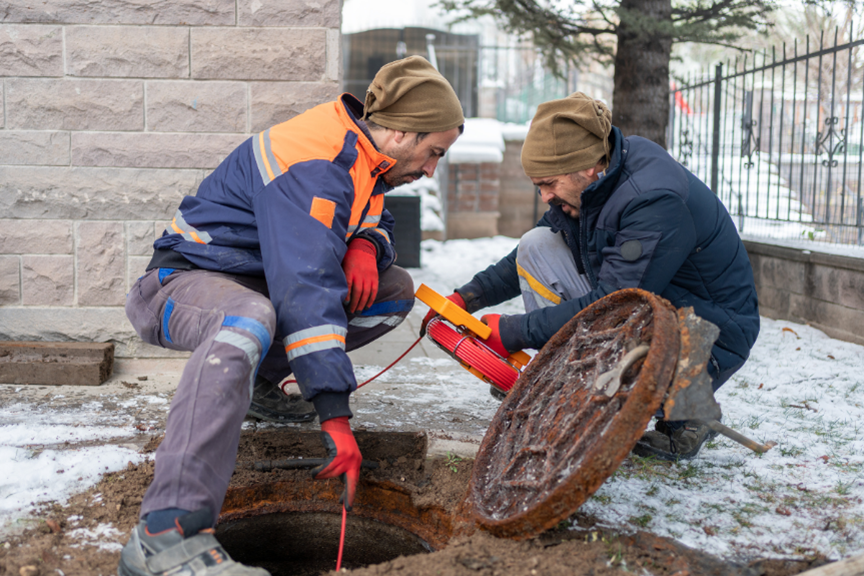
Technicians conducting a manhole inspection with a camera.
This technique is cost-effective, necessitating minimal or no tools and equipment to conduct the inspections compared to other methods. Done proactively, regular manhole inspections help with early detection of I&I and can prolong the life of the system. However, it can be time-consuming and possibly hazardous to complete inspections of a manhole network, especially if located in difficult-to-reach locations or in confined spaces with potential safety risks.
These inspections also rely on the visual judgement of the technician or engineer, which can produce inconsistent reports from a staff with varying interpretations of “deterioration.” However, this budget-friendly method, when combined with other techniques such as accurate flow monitoring, provide a more comprehensive analysis of I&I. Manhole inspections can also be combined with flow meter installation, maintenance, and removal, as many level sensors and meters are installed in and around sewer pipes located in manholes.
The Case for Flow Measurement in I&I Applications
According to a study conducted by the Environmental Protectional Agency (EPA) reviewing the most popular methods for I&I surveillance and analysis, no single methodology could be universally applied due to each method’s various strengths and limitations. Some require data that is difficult to provide or predict, some have trouble predicting or assessing conditions due to seasonality, and many require data acquired from other I&I surveillance methods. Implementing flow monitoring alongside other techniques is the recommended approach for ongoing success.
Real-time flow data allows engineers to make repairs and prevent over capacity at the WWTP, overflows resulting in regulatory noncompliance, and potential damage to the collection system infrastructure.
Flow data can be utilized in real-time, identifying areas with the greatest I&I impact to help prioritize the most severe problems first. Real-time reporting on flow data can also indicate whether the more prevalent issue is influent or infiltration, helping to drive your secondary investigative method, such as smoke testing or pipe inspections.
Even so, the most experienced wastewater engineers know that implementing flow measurement devices can provide real-time, continuous flow data, making it available to their utilities managers and other wastewater professionals to integrate into management software.
A baseline for flow can be established, and thresholds set to indicate unexpected spikes in flow rate and volume; this kind of data allows wastewater engineers to identify I&I problems as they happen, rather than resort to detective work after the I&I has developed into pervasive issues.
Investing in an interconnected network of measurement devices across the wastewater collection system can help minimize future costs of treating rain dependent influent/infiltration (RDII) at the treatment plant. Now the question is: what kind of flow monitoring solutions exist for wastewater engineers?
Hach’s Flow Solutions by McCrometer
Hach’s flow solutions by McCrometer is a suite of open channel products that provide users with reliable, budget-saving flow measurement to reduce the need for manual data collection and monitoring as well as minimize risk and unnecessary site visits.
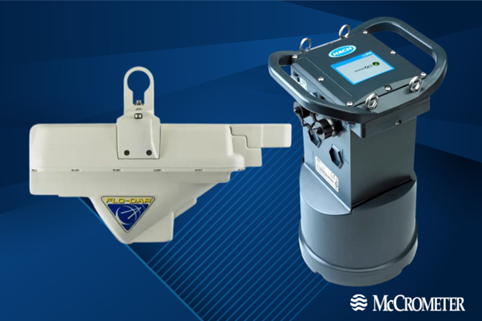
The FLO-DAR® (left) area velocity meter and the FL900 Flow Logger (right).
The FL900 Flow Logger
The FL900 Flow Logger gives customers the utmost in convenience and time savings, producing accurate and reliable open channel flow readings without requiring complicated installation or maintenance.
This compact measurement device boasts a battery life of 6-10 months and can be installed in minutes in a variety of configurations, such as on a manhole ladder, poles, walls, and more. The FL900 provides peace of mind that the unit is installed and ready to monitor open channel flow through its LED indicator confirming correct site setup and meter communication.
Through remote and wireless communications, the FL900 Flow Logger transmits flow data for users to maker real-time decisions regarding collection systems. With the FSDATA™ Online software tool, users no longer need to visit the monitoring sites to collect flow data or adjust meter settings.
The FL900 Flow Logger produces accurate data with a high raw data uptime, producing usable, model-ready data for wastewater engineers and analysts to survey and pinpoint I&I faster and with less effort.
Data Delivery Service (DDS)
The Data Delivery Service (DDS) is the ideal program for municipalities on a budget. This custom solution provides a metering and data management package to meet a municipality’s unique needs, supplying users with state-of-the-art flow measurement instrumentation and software on a month-by-month basis eliminating the need to purchase meters.
DDS deploys world-class equipment including the FL900 Flow Logger as well as FSDATA, and provides maintenance as well, handled by the Hach Flow service team or via training to customers’ staff. DDS is backed by a 95% uptime guarantee, providing peace of mind and ensuring that customers can capture the data needed to identify I&I issues in their sanitary sewer system – or the measurement devices are free for that month!
FLO-DAR®
Designed as a non-contact portable flow monitoring system, the FLO-DAR is an area velocity flow sensor that provides accurate open channel readings via anti-sensor fouling technology. This unit has highly repeatable data results and with little-to-no maintenance required as the no-contact design prevents sensor fouling, making the FLO-DAR an incredibly reliable product for I&I applications.
The FLO-DAR combines Doppler radar velocity-sensing technology with ultrasonic level sensing, producing the perfect measurement solution for challenging flow applications. Sensor installation, removal, and replacement can be accomplished in minutes, and without the need for confined space entry.
This unit can operate up to 3 years without the need for recalibration and provides real-time flow measurements in the most difficult flow conditions including flows with varying temperatures, corrosive and caustic flow media, high solids content, and high velocities.
Investing in Data Management Tools for Influent and Infiltration
Allocating budget for flow measurement equipment and software can be daunting, as various other priorities and expenditures compete for precedence. However, wastewater professionals who identify and analyze I&I with help from flow meters and data automation increase their efficiency and overall effectiveness combatting the problems caused by influent and infiltration.
Strategic implementation and use of flow meters in I&I applications can increase the overall return on investment. Installing portable open channel meters ensures that devices can be easily and quickly transferred from application to application, providing engineers and analysts with various data points within a sanitary sewer system.
Additionally, the option to rent vs. purchase flow monitoring equipment may greatly benefit a short-staffed municipality or one that cannot spare personnel to spend time in the field installing or maintaining meters.
Investing in flow technology to assist in preventing I&I is certainly less of a financial impact, especially in older collection systems where the I&I has been calculated up to 50% of the flow. By implementing efficient flow measurement instrumentation and automating real-time flow data into sophisticated software, WWTPs can better analyze large I&I datasets and draw meaningful insights for actionable results.
For additional information on Hach Flow Solutions by McCrometer, visit the website or contact the factory to learn more about our open channel product suite!
What is Influent and Infiltration (I&I) in sanitary sewer systems?
Influent and Infiltration (I&I) refers to any water that enters sanitary sewer systems through direct or indirect points of entry such as groundwater and stormwater. Influent is typically clean water from sources like manholes, sump pumps, and foundation drains entering directly, while infiltration is water seeping in through cracks or leaks in the pipelines. Both Influent and Infiltration increase the volume of water that must be treated, raising costs and potentially causing overflows.
What are the main methods used to detect and monitor I&I?
Engineers use several methods to detect and monitor I&I, including:
- Flow monitoring (using smart flow meters and real-time data collection)
- Smoke and dye testing (to identify leaks and illegal connections)
- Hydraulic modeling (computer simulations to predict system impacts)
- Manhole inspections (visual and digital assessments for cracks or deterioration)
Each method has strengths and limitations, so a combination is often recommended for comprehensive analysis.
Where can I explore tools available for managing I&I?
You can find a range of solutions for influent and infiltration (I&I) management on McCrometer’s Open Channel flow page. Advanced tools like the FL900 Flow Logger and the FLO-DAR area velocity meter offer reliable, low maintenance flow measurement with features such as wireless data transmission, long battery life, and non-contact sensing to prevent fouling. Services like Data Delivery Service (DDS) provide municipalities with equipment, software, and maintenance on a subscription basis, reducing upfront costs and ensuring high data uptime. Visit the page to review which tools best fit your system’s needs.
Why is managing I&I important for wastewater utilities?
Managing I&I is crucial because excess water can overload wastewater treatment plants, leading to increased operational costs, and potentially cause environmental and safety issues. For example, treating an additional 150 million gallons of I&I annually could cost between $300,000 and $750,000. Effective I&I management helps utilities remain compliant with regulations and prioritize repairs to reduce risks and expenses.
How does flow monitoring help in I&I management, and what are its limitations?
Flow monitoring provides continuous, real-time data on water volumes entering the sewer system, helping engineers identify trends, set baselines, and quickly detect unexpected spikes. This data supports regulatory compliance and infrastructure planning. However, flow monitoring alone cannot identify the exact source of I&I, and its effectiveness depends on proper installation, calibration, and maintenance of the meters. Inaccurate data can mislead decision-making.
Related Posts
Request More Information

